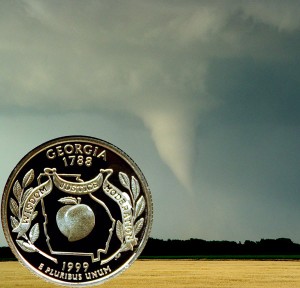Today, the Georgia State Quarter Coin remembers the storm of 1810 and provides an 1810 general description of tornado storms.
From the American Register for 1810, published in 1811:
=====
Savannah, Georgia, April 7, 1810.
On Wednesday, March 28, the citizens of Laurens county, were awakened, a little before sunrise, with an incessant flood of rain, a violent wind, and frequent falling of trees.
In about twenty minutes the alarm became general, and the destruction of every object around seemed to be threatened, by one of the most violent tornadoes, perhaps, ever witnessed in Georgia.
So great has it been in its ravages that whole forests have been laid prostrate, and some of the finest high land in this state rendered an heap of ruins.
Many of the best plantations have become unfit for immediate cultivation; houses, fences and stock have been swept away or destroyed; and the distress of the planters, (many of whom were new settlers, and had just began to surmount their difficulties) is indescribable.
Some of them have lost their all, having neither a horse to plough, nor a cow to milk.
The width of the tornado is supposed to have been about six miles; but its extent has not been ascertained.
It passed over the Oakmulgee, about the 7th district of Baldwin, in an easterly direction.
=====
From the Monthly Magazine, October 1810:
=====
Tornados are violent gusts of wind, which come from the eastward, attended by thunder, lightning, and, in general, heavy rain. The violence of the wind seldom continues longer than half an hour; but the scene during the time it continues may be considered as one of the most awfully sublime in nature.
Its approach is foretold, by certain appearances, which enable people to be on their guard.
A dark cloud, not larger than ‘a man’s hand,’ is just observed on the verge of the eastern horizon.
Faint flashes of lightning, attended sometimes by very distant thunder, are then seen to vibrate in quick succession.
The clouds in that quarter become gradually more dense and black; they also increase in bulk, and appear as if heaped on each other.
The thunder, which at first was scarcely noticed, or heard only at long intervals, draws nearer by degrees, and becomes more frequent and tremendous.
The blackness of the clouds increases, until a great part of the heavens seems mapped in the darkness of midnight; and it is rendered still more awful, by being contrasted with a gleam of light which generally appears in the western horizon.
Immediately before the attack of the tornado, there is either a light breeze, scarcely perceptible, from the westward, or, as is more common, the air is perfectly calm and unusually still.
Men and animals fly for shelter; and, ‘while expectation stands in horror,’ the thundering storm in an instant bursts from the clouds.
It is impossible for language to convey a just idea of the uproar of the elements which then takes place.
The temperature of the air is greatly affected by a tornado. It becomes cool and clear; and it is not unusual for the thermometer to suffer a depression of eight or ten degrees within two or three minutes after the storm has come on.
After a tornado, the body feels invigorated and more active, and the mind recovers much of that elasticity which long-continued heat tends to impair.
— The above is taken, with two or three slight verbal changes, from Dr. Winterbottom’s able and accurate Account of Sierra Leone, p. 24, &c.
=====
The Georgia State Quarter Coin shows with an image of a tornado forming in a storm cell.
